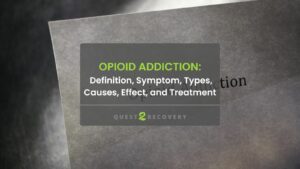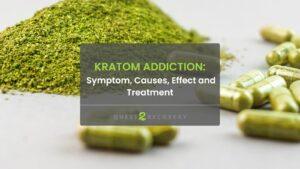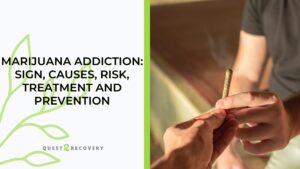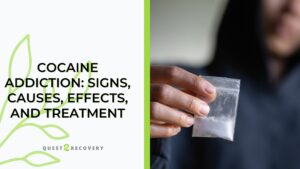Opioid addiction, or opioid use disorder (OUD), involves compulsive opioid use despite negative outcomes. Opioids encompass prescription painkillers like oxycodone, hydrocodone, and illegal drugs such as heroin. This misuse has sparked an epidemic of addiction and overdose deaths, posing a significant public health concern.
Opioid addiction symptoms include compulsive drug use, increased tolerance, withdrawal symptoms, excessive time seeking or using opioids, neglecting responsibilities, social isolation, mood swings, and continued use despite wanting to quit. Physical signs like pinpoint pupils, drowsiness, slurred speech, and respiratory depression also occur.
Opioid addiction types include prescription opioids, synthetic opioids such as fentanyl, heroin, and illicitly manufactured fentanyl (IMF).
Opioid addiction is often caused by exposure to prescription opioids, leading to dependence and misuse. Genetic factors, psychological issues like trauma or stress, social influences, and accessibility to opioids also give rise to addiction development.
Opioid addiction effects include severe physical health issues like respiratory problems and infections, mental health challenges such as depression and anxiety, strained relationships, financial troubles, and legal problems, ultimately impacting overall functioning negatively.
Opioid addiction treatment combines medication-assisted treatment (MAT) with medications like buprenorphine or methadone, along with cognitive-behavioral therapy (CBT) and support groups like Narcotics Anonymous (NA). Holistic approaches, relapse prevention education, and family involvement are also essential components.
What Is Opioid Addiction?
Opioid addiction, formally known as opioid use disorder (OUD) according to the Diagnostic and Statistical Manual of Mental Disorders (DSM-5), is a chronic and relapsing condition characterized by compulsive opioid use, loss of control over use, and major impairment in daily functioning. Individuals with OUD often experience cravings, withdrawal symptoms upon cessation, and a strong desire to continue using opioids despite negative consequences.
According to a 2020 research report, Medications to Treat Opioid Use Disorder, approximately 2.7 million individuals aged 12 or older in the United States were reported to have experienced an opioid use disorder (OUD) within the past year, with around 2.3 million of them specifically affected by prescription opioid use disorder.
The surge in opioid-related deaths has been staggering, reaching 80,411 fatalities in 2021. Apart from fatalities, the opioid crisis has resulted in other adverse outcomes, such as a notable increase in the number of infants born dependent on opioids due to maternal substance use during pregnancy, as well as a heightened prevalence of infectious diseases like HIV and hepatitis C (HCV), notably observed in southern Indiana in 2015.
What Are the Symptoms of Opioid Addiction?
The symptoms of opioid addiction vary in severity and presentation but generally include:
- Compulsive Drug Seeking: Individuals with opioid addiction often engage in compulsive behaviors to obtain opioids, including visiting multiple doctors (“doctor shopping”), faking or exaggerating symptoms to get prescriptions, stealing medication, or buying opioids illegally.
- Tolerance: Over time, the body becomes accustomed to opioids, requiring higher doses to achieve the desired effects. Tolerance is a hallmark of addiction and leads to escalated opioid use.
- Withdrawal Symptoms: When opioids are not used or the dosage is reduced, individuals experience withdrawal symptoms, which are highly uncomfortable and drive continued drug use. Withdrawal symptoms include nausea, vomiting, diarrhea, sweating, muscle aches, restlessness, anxiety, insomnia, and irritability.
- Cravings: Strong cravings for opioids are common in addiction. These cravings are intense and persistent, occasioning individuals to prioritize obtaining and using opioids over other aspects of their lives.
- Loss of Control: Individuals with opioid addiction often struggle to control their drug use, even when they recognize the negative consequences. They repeatedly try to cut down or quit but are unable to do so.
- Neglecting Responsibilities: Addiction to opioids spawns neglecting responsibilities at work, school, or home. Individuals miss deadlines, skip classes or workdays, neglect household chores, or withdraw from social activities.
- Financial Problems: Supporting an opioid addiction is financially burdensome. Individuals spend excessive amounts of money on obtaining opioids, leading to financial strain, debt, and borrowing money from others.
- Social Isolation: Addiction breeds social isolation as individuals prioritize drug use over spending time with family and friends. They withdraw from social activities, avoid social gatherings, or distance themselves from loved ones.
- Physical Symptoms: Prolonged opioid use generates physical changes and health issues. Physical symptoms of opioid addiction comprise pinpoint pupils, drowsiness, slowed breathing, constipation, weight loss, skin infections (from injecting opioids), and poor hygiene.
- Psychological Symptoms: Opioid addiction impacts mental health. Individuals experience mood swings, irritability, anxiety, depression, paranoia, hallucinations, and cognitive impairment.
- Risk-Taking Behavior: Addiction precipitates risky behaviors, such as driving under the influence of opioids, engaging in unsafe sexual practices, or taking dangerous drug combinations.
- Legal Issues: Misuse of opioids causes legal problems, including arrests for possession of illegal drugs, prescription fraud, theft, or driving while impaired.
Opioid addiction is characterized by a range of physical, psychological, social, and behavioral symptoms that substantially impact an individual’s life and well-being. Early recognition of these symptoms is crucial for prompt intervention and treatment.
What Are the Types of Opioid Addiction?
Opioid addiction is classified into different types based on various factors. Here are the common types of opioid addiction:
- Prescription Opioid Addiction: This type of addiction occurs when individuals misuse or become dependent on prescription opioids prescribed for pain management. Examples of prescription opioids include oxycodone (OxyContin), hydrocodone (Vicodin), codeine, and morphine.
- Heroin Addiction: Heroin is an illegal opioid derived from morphine. Individuals transition to heroin addiction after misusing prescription opioids or start using heroin directly. Heroin is highly addictive and constitutes considerable health risks.
- Synthetic Opioid Addiction: Synthetic opioids are man-made substances designed to mimic the effects of natural opioids. Examples include fentanyl and tramadol. Synthetic opioids are potent and originate rapid development of addiction.
- Illicitly Manufactured Fentanyl (IMF) Addiction: IMF refers to illegally produced fentanyl and its analogs. These substances are often mixed with other drugs like heroin or cocaine, increasing the risk of overdose and addiction. IMF addiction has contributed to a surge in overdose deaths in recent years.
- Polydrug Addiction: Some individuals develop addiction to a combination of opioids and other substances, such as alcohol, benzodiazepines, or stimulants. Polydrug addiction complicates treatment and accelerates health risks.
- Intravenous (IV) Drug Use Addiction: Addiction is also divided predicated on the route of administration. IV drug use, where opioids are injected directly into the bloodstream, is associated with a higher risk of infectious diseases, overdose, and rapid addiction development.
These types of opioid addiction overlap or co-occur, and individuals transition between different types depending on their drug use history, availability of opioids, and personal circumstances. Each type of opioid addiction requires tailored treatment approaches to address specific needs and challenges.
What Are the Causes of Opioid Addiction?
The causes of opioid addiction are multifaceted and vary from individual to individual. Here are the common factors contributing to opioid addiction:
- Exposure to Prescription Opioids: One of the primary causes of opioid addiction is exposure to prescription opioids for pain management. Individuals prescribed opioids for legitimate medical reasons develop dependence or misuse of the medication, leading to addiction.
- Genetic Predisposition: Genetic factors play a role in addiction susceptibility. Certain genetic variations influence how individuals respond to opioids, affecting their risk of developing addiction.
- Psychological Factors: Psychological issues such as trauma, stress, anxiety, depression, or co-occurring mental health disorders produce opioid addiction. Some individuals use opioids as a coping mechanism to alleviate emotional distress or manage underlying psychological issues.
- Social Influences: Social factors like peer pressure, social norms around substance use, family history of addiction, and exposure to drug-using environments inveigle addiction risk. Individuals surrounded by peers or family members who use opioids are more likely to develop addiction themselves.
- Accessibility of Opioids: Easy access to opioids, whether through legitimate prescriptions, illicit drug markets, or social networks, increases the likelihood of misuse and addiction. The availability and affordability of opioids contribute to their widespread use and misuse.
- Chronic Pain Management: Individuals with chronic pain conditions who rely on opioids for long-term pain management are at risk of developing addiction. The use of opioids for extended periods or at high doses creates tolerance, dependence, and addiction.
- Biological Factors: Neurobiological factors, including changes in brain chemistry and neurotransmitter systems, play a role in addiction development. Opioids act on the brain’s reward pathways, producing pleasurable effects and reinforcing drug-seeking behaviors.
- Early Exposure to Substance Use: Early initiation of substance use, including experimentation with opioids or other drugs during adolescence, increases the risk of developing addiction later in life. Early exposure alters brain development and expands the vulnerability to addiction.
- Stigma and Lack of Treatment: Stigma associated with addiction and barriers to accessing treatment prevent individuals from seeking help or receiving timely interventions. Limited availability of addiction treatment services or inadequate support systems exacerbate addiction issues.
- Polydrug Use: Concurrent use of opioids with other substances, such as alcohol, benzodiazepines, or stimulants, increases the risk of addiction and complicates treatment outcomes.
What Are the Effects of Opioid Addiction?
Opioid addiction has profound effects on various aspects of an individual’s life, impacting physical health, mental well-being, social interactions, and overall quality of life. Here are the effects of opioid addiction:
- Physical Health Consequences: Prolonged opioid use sparks a range of physical health issues, including respiratory depression, decreased heart rate, constipation, hormonal imbalances, weakened immune system, increased risk of infections (such as HIV and hepatitis C from needle sharing), liver damage, and cardiovascular complications.
- Overdose and Death: Opioid addiction remarkably increases the risk of overdose, whose consequences are respiratory failure, coma, and death. The potency of opioids like fentanyl has contributed to a surge in overdose deaths in recent years, highlighting the life-threatening consequences of addiction.
- Mental Health Impact: Opioid addiction is often associated with mental health disorders such as depression, anxiety, post-traumatic stress disorder (PTSD), and cognitive impairment. Addiction magnifies existing mental health conditions, leading to emotional instability, mood swings, and impaired decision-making.
- Social and Relationship Challenges: Addiction to opioids strains relationships with family members, friends, and colleagues. Individuals encounter social isolation, withdrawal from social activities, and difficulties maintaining healthy interpersonal connections. The focus on obtaining and using opioids overshadows other aspects of life, leading to conflicts and strained relationships.
- Financial Strain: Supporting a drug addiction is financially draining. Individuals spend notable amounts of money on obtaining opioids, leading to financial instability, debt, and borrowing money from others. Job loss, reduced earning capacity, and legal expenses further contribute to financial challenges.
- Legal Issues: Misuse of opioids results in legal problems, including arrests for possession of illegal drugs, prescription fraud, theft, or driving under the influence of opioids. Legal issues turn to criminal charges, fines, probation, and incarceration, exacerbating the consequences of addiction.
- Stigmatization: Opioid addiction is often stigmatized, leading to discrimination, social ostracism, and barriers to accessing healthcare, employment, and social support. Stigma exacerbates feelings of shame, guilt, and low self-esteem among individuals struggling with addiction.
- Impact on Families: Opioid addiction has ripple effects on families, causing emotional distress, financial strain, disrupted family dynamics, and challenges in caregiving. Family members face stress, anxiety, depression, and feelings of helplessness or frustration in supporting a loved one with addiction.
How Do You Treat Opioid Addiction?
Opioid addiction is treated using a combination of approaches that address physical dependence, psychological factors, behavioral patterns, and social aspects of addiction. Here are the key components of opioid addiction treatment:
- Medical Detoxification: Medically supervised detoxification is the first step in treatment, where individuals undergo withdrawal under medical supervision. Medications are administered to manage withdrawal symptoms and ease the detox process, ensuring safety and comfort.
- Medication-Assisted Treatment (MAT): MAT combines medications with behavioral therapies to address opioid addiction comprehensively. Medications such as buprenorphine, methadone, and naltrexone are used to reduce cravings, prevent withdrawal symptoms, and normalize brain chemistry. MAT is effective in supporting long-term recovery and reducing the risk of relapse.
- Behavioral Therapies: Behavioral therapies such as cognitive-behavioral therapy (CBT), contingency management, motivational interviewing (MI), and dialectical behavior therapy (DBT) are integral to addiction treatment. These therapies help individuals modify addictive behaviors, develop coping skills, address underlying issues contributing to addiction, and improve decision-making skills.
- Support Groups: Participation in support groups such as Narcotics Anonymous (NA), SMART Recovery, or group therapy sessions provides peer support, encouragement, and accountability during recovery. Support groups promote social connection, sharing of experiences, and learning from others in similar situations.
- Holistic Approaches: Holistic therapies and complementary treatments, such as mindfulness meditation, yoga, acupuncture, art therapy, and exercise, are beneficial in promoting overall well-being and aiding in addiction recovery. These approaches focus on healing the mind, body, and spirit and enhance the effectiveness of traditional treatments.
- Education and Relapse Prevention: Education about opioid addiction, relapse triggers, coping strategies, and healthy lifestyle changes are crucial for long-term recovery. Developing a relapse prevention plan, identifying triggers, and learning effective coping skills help individuals maintain sobriety and prevent relapse.
- Family Involvement: Involving family members in the treatment process through family therapy, education, and support services improves outcomes and facilitates a supportive environment for recovery. Family therapy addresses communication issues, codependency, enabling behaviors, and rebuilding trust and relationships.
- Continuing Care and Aftercare: After completing initial treatment, ongoing care and support are essential for sustained recovery. Continuing care incorporates regular therapy sessions, medication management, support group attendance, vocational training, housing assistance, and access to community resources. Aftercare plans are tailored to individual needs and focus on maintaining recovery and enhancing quality of life.
Effective opioid addiction treatment is comprehensive, individualized, and multidisciplinary, addressing the complex nature of addiction and supporting individuals in achieving long-term sobriety, improved health, and overall well-being. Collaboration between healthcare providers, addiction specialists, therapists, support groups, and community resources is critical in providing holistic care and promoting successful recovery outcomes.
How do I prevent opioid addiction relapse?
Preventing opioid addiction relapse involves developing coping skills, identifying triggers, maintaining a healthy lifestyle, attending support groups, and staying connected to a supportive community. Creating a relapse prevention plan, practicing self-care, and seeking ongoing support are key strategies in sustaining recovery.
What do I do if I suspect a loved one is struggling with opioid addiction?
If you suspect a loved one is struggling with opioid addiction, express your concerns with compassion and encourage them to seek professional help. Offer support, provide information about treatment options, and avoid judgment or blame. Family therapy and support groups are also beneficial in addressing addiction within the family unit.
How long does opioid addiction treatment typically last?
The duration of opioid addiction treatment varies depending on individual needs, progress, and treatment plan. Treatment pendulates from several weeks to months or even years, with ongoing support and aftercare playing a crucial role in maintaining recovery.
How does opioid addiction differ from cocaine addiction?
Opioid addiction and cocaine addiction differ in their mechanisms of action, physical effects, withdrawal symptoms, and treatment approaches. While opioids primarily act on the brain’s opioid receptors to reduce pain and induce euphoria, cocaine blocks neurotransmitter reuptake, leading to increased dopamine levels and heightened alertness. Withdrawal from opioids typically involves flu-like symptoms, while cocaine withdrawal may manifest as depression and fatigue. Treatment for opioid addiction often includes medication-assisted therapy, whereas cocaine addiction treatment focuses more on behavioral therapies and counseling.
What are the risks of quitting opioids cold turkey?
Quitting opioids abruptly (cold turkey) brings about severe withdrawal symptoms, including nausea, vomiting, diarrhea, muscle aches, anxiety, and insomnia. It also augments the risk of relapse due to intense cravings. Medical supervision and gradual tapering of opioids are recommended for safe detoxification.









